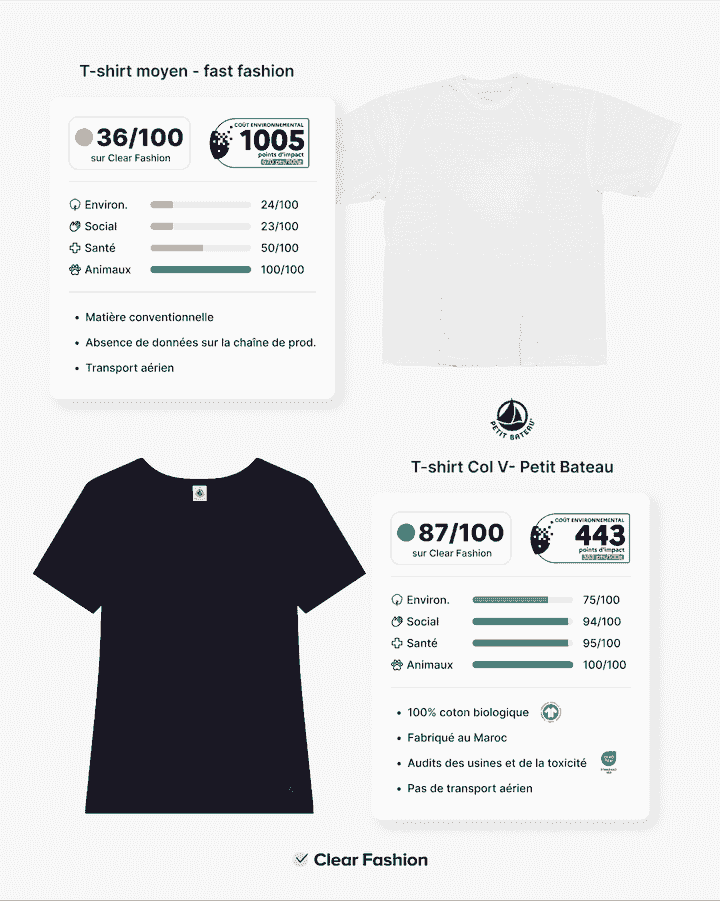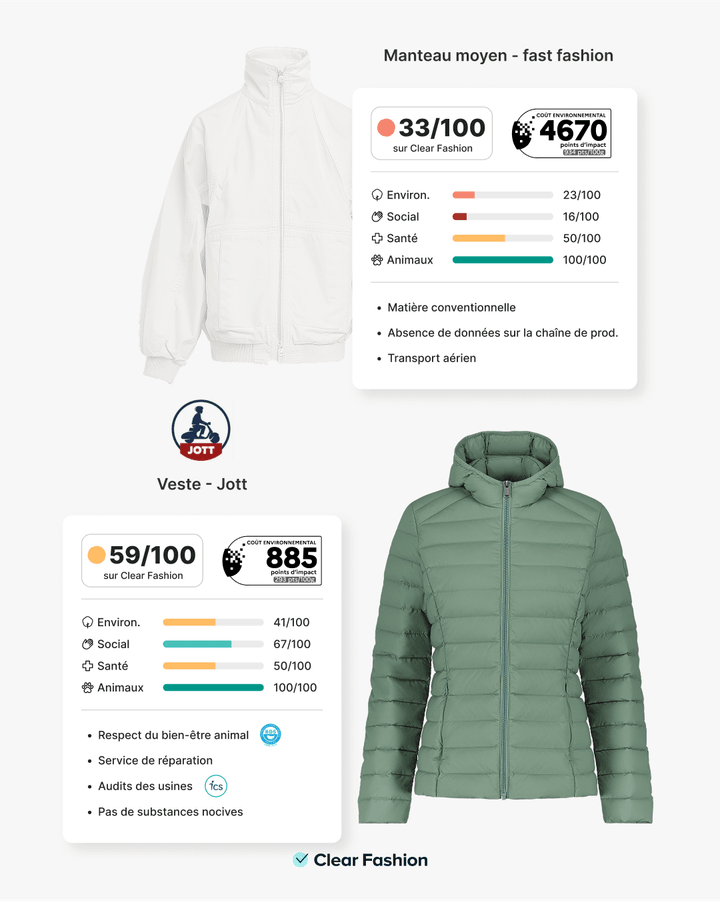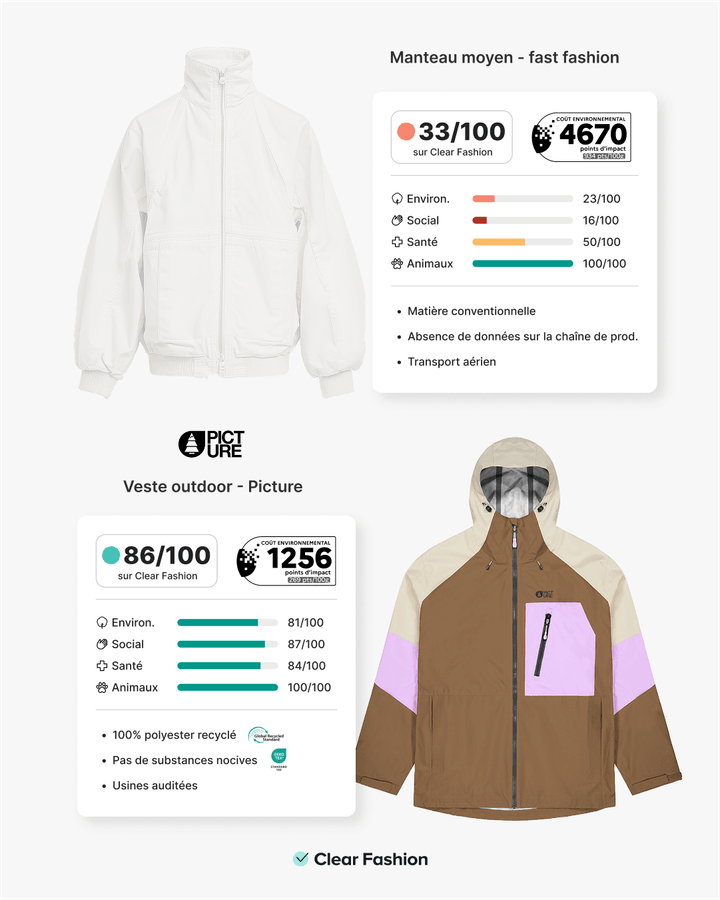
Textile Environmental Labeling : It’s Official. Now, Let’s Take Action.
The textile environmental labeling decree has been approved by the European Commission — a key regulatory milestone. But for this to truly transform the sector, it needs to be visible, understandable, and concrete. That’s Clear Fashion’s mission.

📆 A Major Political Milestone
Since 2020, Clear Fashion has been actively involved in setting up this system, alongside the Ministry of Ecological Transition.
✔ Recommended by the Citizens’ Convention
✔ Included in the Climate and Resilience Law
✔ 6 years of work, backed by a rigorous public methodology
And now, the decree has been approved by Europe.
🎯 What is the environmental cost?
It’s a quantified estimate of a product’s environmental impact (water, carbon, biodiversity, etc.).
> The higher the score, the greater the impact.
> Soon, you’ll be able to compare a t-shirt to... a car trip or a chocolate bar.
🇫🇷🇪🇺 France and the EU are (finally) moving in the same direction.
Good news for international brands navigating both national and European regulations: alignment is underway between the French environmental labeling system Ecobalyse and the EU's Product Environmental Footprint (PEF) framework.
In May 2025, the European Commission approved the French decree introducing Ecobalyse, recognizing it as a coherent, robust, and actionable methodology for environmental impact labeling in the fashion sector.
At the same time, the EU confirmed that PEF cannot be used for consumer-facing labeling in apparel and footwear: “The PEFCR regulation does not authorize the use of a single score for communication between businesses and consumers.”
👉 What this means for brands : Ecobalyse is a credible and forward-compatible framework for environmental labeling — and it is likely to influence future European standards.
🕵️♂️ Soon, anyone will be allowed to disclose environmental scores for your products
Starting in 2026, any third party — NGOs, media outlets, platforms — will be allowed to calculate and publish the environmental impact scores of your products, even without your consent. This is one of the specific features of the French decree: default scores (often unfavorable) will be made public to accelerate the industry's transition.
⚠️ This means organizations like UFC-Que Choisir, 60 Millions de Consommateurs, or Open Product Facts could publish scores for your garments — using publicly available data or default assumptions.
👉 Take the lead : by publishing your own scores, you control the data used, shape the message, and highlight your sustainability efforts.
💶 Bonus-malus: Your environmental impact will soon pay or cost
Passed in its first reading by the French Senate on June 4, 2025, the anti-fast fashion law marks a historic turning point.
This legislative framework aims to regulate production volumes, reward responsible brands, and penalize the most polluting practices.
Producer Responsibility (EPR) contributions will now be adjusted through bonuses and penalties based on certain environmental labeling criteria — particularly those related to product durability, such as traceability, repairability, and product range diversity. Environmental labeling is becoming a key tool to anticipate and guide the industry's transformation !
Our role in deployment : making the system clear and accessible
We didn’t just contribute to it.
✔ Largest contributor to the national pilot (15,000 products evaluated)
✔ The only consumer-facing score featured in government materials
✔ An active community of over 400,000 consumers
✔ A tool already used by 300+ brands, with 7 million monthly consumer views of our scores
The Fashion Score : a comprehensive, educational label
The Fashion Score doesn’t just provide a rough estimate of impact — it analyzes production methods. It also includes:
- 👕 Social (working conditions)
- 💊 Health (toxic substances)
- 🐑 Animal welfare
It’s expressed on a scale of 0 to 100 with a simple color code — a real guide for everyone.

We analyzed two full looks to give you a clear picture of how this really plays out.
Women’s Outfit: Petit Bateau – Cyrillus – Jott
3,724 impact points (vs. 10,110 for a similar fast fashion outfit)
🟢 Average Fashion Score : 73/100 (vs. 🔴 34/100 for fast fashion)Men’s Outfit: Faguo – 1083 – Picture
4,374 impact points (vs. 12,818 for a similar fast fashion outfit)
🟢 Average Fashion Score : 88/100 (vs. 🔴 34/100 for fast fashion)


Women T-shirt
Comparison: Petit Bateau women's t-shirt vs average anonymous fast fashion brand t-shirt

Men Sweater
Comparison: Faguo men's sweater vs average anonymous fast fashion brand sweater

Women Jean
Comparison: Cyrillus mom jeans vs average anonymous fast fashion brand jeans

Men Jean
Comparison: 1083 men's jeans vs average anonymous fast fashion brand jeans

Women Jacket
Comparison: Jott women's jacket vs average anonymous fast fashion brand jacket

Men Jacket
Comparison: Picture men's jacket vs average anonymous fast fashion brand jacket
Brand?
✉️ Schedulde a meeting or write to us to evaluate your products at hello@clear-fashion.com
Consumer?
👉 Call out your favorite brands, see the toolkit here
The labelling is voluntary for now. But YOU can make it essential.
📩 Email, 💬 comment, 🤝 direct request = every action matters.
Journalist?
Discover our press release and visuals
Clear Fashion — Making Transparency the Norm!
Want to join us?











